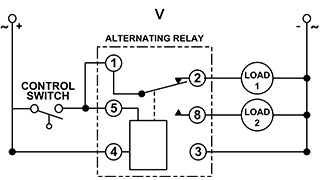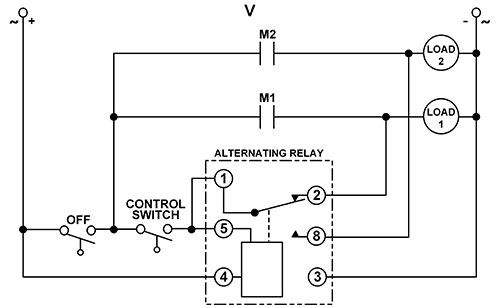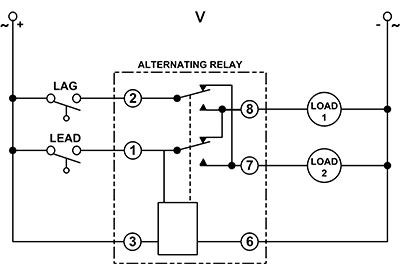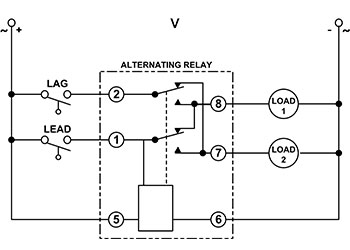Typical Applications for Alternating Relays
Issue:
How do I make connections to my Alternating Relay?
Solution/Resolution:
Macromatic offers several versions of Duplex Alternating Relays. The following examples are typically the way connections are made to the relays. The loads could be pumps, compressors, or air conditioning/refrigeration units:
SPDT (Figure A) & DPDT (Figure B)In the off state (Figure A), the Control Switch is open, the Alternating Relay is in the LOAD 1 position, and both LOAD 1 & LOAD 2 are off. The red LED marked "LOAD 1" is ON. When the Control Switch closes, it energizes LOAD 1. As long as the Control Switch remains closed, LOAD 1 remains energized. When the Control Switch opens, LOAD 1 is turned off and the Alternating Relay toggles to the LOAD 2 position. The red LED marked "LOAD 2" is ON. When the Control Switch closes again, it energizes LOAD 2. When the Control Switch opens, LOAD 2 is turned off, the Alternating Relay toggles back to the LOAD 1 position, the red LED marked "LOAD 1" is ON, and the process can be repeated. |
Figure A |
| A DPDT Alternating Relay is the same as a SPDT but with an extra set of NO & NC contacts. As shown in Figure B, these extra contacts can be used for pilot lights or other indications. | 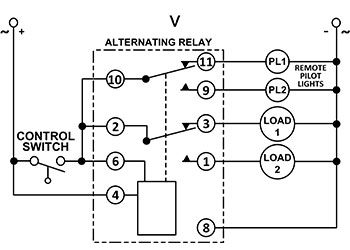 Figure B |
|
Although normally used with one input device, a SPDT Alternating Relay can also be used with two input devices where the first input device works as the “OFF” switch. In Figure C, a second input device called the “OFF” switch is added along with one auxiliary contact on each Load contactor. In the initial OFF state, both input switches are open, the Alternating Relay is in the LOAD 1 position, and both loads are off. No action happens with the Alternating Relay or either load when the OFF switch closes. When the Control Switch closes, Contactor M1 turns ON, closing auxiliary contact M1 and turning on LOAD 1. When the Control Switch opens, LOAD 1 remains on because the OFF Switch is still closed and auxiliary contact M1 from Contactor M1 is still closed. When the OFF Switch opens, LOAD 1 turns off. Auxiliary contact M1 opens. The Alternating Relay toggles to the LOAD 2 position. The entire cycle is then repeated, but with LOAD 2 energized first. |
|
DPDT Cross-WiredIn the off state (Figure D), both the LEAD Switch and the LAG Switch are open, the Alternating Relay is in the LOAD 1 position, and both LOAD 1 & LOAD 2 are off. The red LED marked "LOAD 1" is ON. When the LEAD Switch closes, it energizes LOAD 1. As long as the LEAD Switch remains closed, LOAD 1 remains energized. If the LAG Switch closes, it energizes LOAD 2. When the LAG Switch opens, LOAD 2 is turned off. When the LEAD Switch opens, LOAD 1 is turned off and the Alternating Relay toggles to the LOAD 2 position. The red LED marked "LOAD 2" is ON. When the LEAD Switch closes, it turns on LOAD 2. If the LAG Switch closes, it will energize LOAD 1. When the LAG Switch opens, LOAD 1 is turned off. When the LEAD Switch opens, LOAD 2 is turned off, the Alternating Relay toggles back to the LOAD 1 position, the red LED marked "LOAD 1" is ON, and the process can be repeated. NOTE: the LEAD switch must always close before the LAG switch and must always open after the LAG switch. |
Figure D |
|
Figure E is the same function but shown for DPDT Cross-Wired Alternating Relays that have the input voltage connected to Pins 5 & 6 instead of Pins 3 & 6 as shown in Figure D. |
Figure E |
| A DPDT Cross-Wired Alternating Relay can be used with three input devices: OFF, LEAD & LAG. For more details, click here for our Knowledge Base Article on “Sequence On-Simultaneously Off Operation”. | |
For special situations, please refer to the index of Knowledge Base Articles for Alternating Relays for other articles. Or contact Macromatic at 800-238-7474.
Recent Articles for:
Alternating Relays
- Jun2020 Triplex Pump Control Using Cost-saving Alternating Relays
- Aug2019 What is Sequence On – Simultaneous Off (S.O.S.O. or SOSO) Operation on Pump Control?
- Aug2019 Typical Applications for Alternating Relays
- Nov2018 Using Alternating Relays with DC Input Voltages
- Jan2018 Using DPDT Cross-Wired Alternating Relays with HIGH-LOW Float Switches

